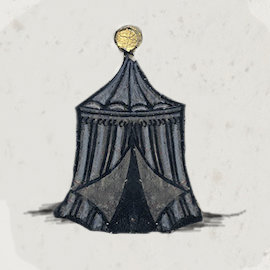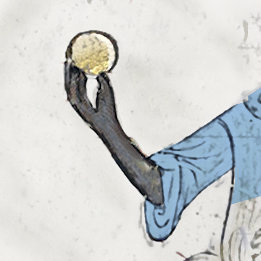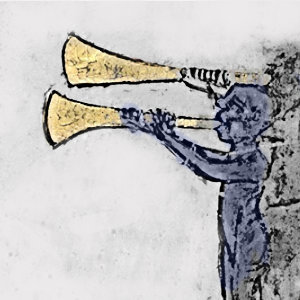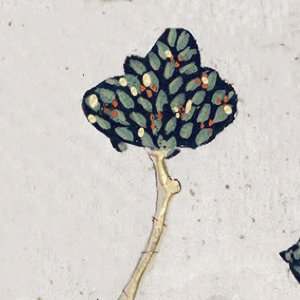Descartes compared blood formation to the fermentation of grapes into wine, “quand on les laisse cuver sur la râpe”. What is this “râpe”, and what does it tell us about Descartes’ idea of the human body? Carmen Schmechel traces this Cartesian analogy in wineries and museums.
Descartes and fermentations in physiology
The phenomenon of life and its origins, be they material or spiritual, have preoccupied philosophers since the dawn of time. While the very “why” of life (why does organic life come to be, whence does the life drive originate) remains an unsolved philosophical question even in our own age, nevertheless the particular molecular processes that sustain organic life have been explored and elucidated to a considerable extent.
Did the heart move on its own – or was there perhaps a „soul“ that moved the heart?
But for seventeenth-century natural philosophers, the ‘mechanisms of living bodies’ were still much of a mystery. Were they entirely physical? Did the heart move on its own – or was there perhaps a “soul” that moved the heart? If the latter was true, was that soul external to the body, or internal? None of this was self-understood at the time when Descartes undertook his own explorations.
For his part, Descartes proposed an idea quite innovative for his time: that the phenomenon of life originates in a fermentational heat coming from the fermentation of blood in the heart. Keen on eliminating the vegetative and nutritive souls from physiology – the faculties that, in various versions, had been accounting for animal (or organic) life since Aristotle – Descartes replaces them, functionally, with a fermentational fire in the heart, which becomes the root of life itself.
To be sure, the beating of the heart, while carrying a central significance “It is so important to know the true cause of the heart’s movement that without such knowledge it is impossible to know anything which relates to the theory of medicine. For all the other functions of the animal are dependent on this.” Description of the Human Body (AT XI 245, English translation from CSM I 319). in Cartesian physiology, was by far not the only physiological process where Descartes presumed fermentations to be at work. In fact, it has been understated how massively his physiological theories are resting upon analogies with fermentational processes in the natural world. In particular, the maturation of wine is a recurrent analogy, which Descartes also invokes to explain digestion, blood formation, the movement of the muscles, and even the generation of the embryo. Primae Cogitationes, AT XI 507; La Description du Corps Humain, AT XI 253. For more details see my forthcoming chapter “Fermentation and Animal Spirits in Descartes’ Medical Philosophy: Muscle Movement and Generation”, due to appear in: Baldassarri, Descartes and Medicine (2022). When God made man, says Descartes, He enkindled “in his heart one of those fires without light that I have already explained, and which I do not conceive at all to be of a different nature than the one which heats the hay when it has been enclosed before it turned dry, or the one which makes new wines seethe when one leaves them to mature on the grapevine shoots”: This is my proposed translation.
il excitast en son coeur un de ces feux sans lumiere, que j’avois desia expliquez, & que je ne concevois point d’autre nature que celuy qui echaufe le foin, lorsqu’on l’a renferme avant qu’il fust sec, ou qui fait bouillir les vins nouveaux, lorsqu’on les laisse cuver sur la rape. Discours, AT VI 46, see also AT IV 189 for a similar expression. For available translations see CSMK I 134, ‘causes new wine to seethe when it is left to ferment from the crushed grapes’; also Maclean’s ‘makes new wine rise in temperature, when it is left to ferment on the lees’: Descartes, A Discourse on the Method, a new translation by Ian MacLean, Oxford: Oxford University Press, 2006, pp. 38–39. ‘Lees’ could refer to one of the meanings of “rape” which is that of “wine pomace” which would include the seeds, the skins, the rachis and other yeasty residue. On the other hand, the “fermenting” is here a term introduced by both translations; Descartes successfully circumvents it, replacing it with maturation, although it is clear that he refers to fermentation. This terminological acrobatics is a recurring feature in Descartes’ physiological writings especially after 1640. For the background and possible reasons, see Schmechel C (2022). „Descartes on fermentation in digestion: iatromechanism, analogy and teleology.“ The British Journal for the History of Science 1–16.
When I started to explore these analogies, a couple of details puzzled me. One of them referred to a specific word choice. What exactly is ‘la rape’ or ‘râpe’, which seemed to have fairly successfully evaded translation?
Rape, râpe, raspe, rafle: An insight into winemaking
To describe physiological processes such as digestion, Descartes compared them to the fermenting of grapes, of which he wrote time and again, “quand on les laisse cuver sur la rape”. They are left to mature… But on what? Could it possibly be a part of the wine press, such as a tray? A branch? The Godefroy dictionary explains “rape” (p. 597) as meaning either grated matter, such as grated cheese, or sending to “raspe”, a concept related to foliage, branches, or forest (p. 609). See Frederic Godefroy, Dictionnaire de l’ancienne langue française et de tous ses dialectes du IXe au XVe siècle,1889, Vol. 6. Parsommer-Remembrance (print edition). None of these meanings proved quite applicable. Or, as other dictionaries suggest, a grater (also called a rasp or rasper), This is another possible meaning, offered by many dictionaries as a first and sometimes only option. Le Dictionnaire de l’Académie française of 1694offers as sole option for rape: „RAPE RAPE. s. f. Outil, espece de lime dont se servent les Sculpteurs pour mettre leur ouvrage en estat de recevoir le dernier achevement. Cette figure est en estat d‘ y passer la rape. La rape sert aussi quelquefois aux Menuisiers, aux Plombiers, & autres ouvriers.Rape, signifie aussi, Une certaine ustensile de mesnage qui sert à égruger du sucre, de la muscade, de la crouste de pain, & autres choses semblables. Une rape de fer blanc.“ which might have helped with breaking the skin of the grapes to initiate fermentation? Such a detail might have given us insight into how coeval technologies of winemaking would have left their mark on Cartesian medicine. But I wasn’t sure that this was the case, and so I kept my options open.
There, in a slightly damp and dark museum cellar, surrounded by the faint scent of ancient wood, I looked closer at a few displayed wine presses which could have been in use in Descartes’ time
In search of this elusive ‘râpe’, I went to France to look for clues in the Alsace, a known wine region. After fruitless inquiries at local wineries, a visit at the Unterlinden Museum in Colmar seemed promising. There, in a slightly damp and dark museum cellar, surrounded by the faint scent of ancient wood, I looked closer at a few displayed wine presses which could have been in use in Descartes’ time. Which part could be the ‘râpe’? And why was it significant that the wines matured on this ‘râpe‘, anyway? Was there an alternative – could they have possibly matured without the ‘râpe’?
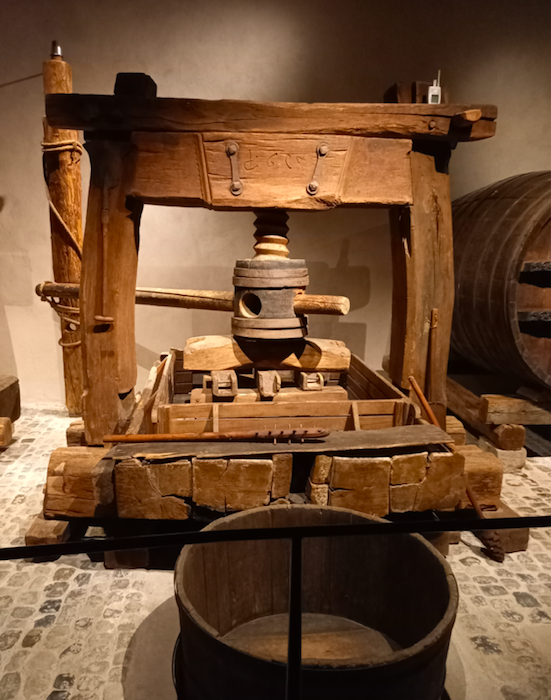
I photographed the wine presses, imagining them heavy laden with grape bunches, then the fruit being pressed, the berries bursting and the clear, fresh grape juice flowing into that open barrel in the front.
To my great disappointment, none of this brought me any further with the ‘râpe’.
It was only when communicating with a kind museum curator, Mr. Raphaël Mariani, that my mystery was solved. Mr. Mariani explained to me that the ‘râpe’ designates the grapevine shoots or the grape stem or stalk (also called rachis.)

According to Mr. Mariani’s enlightening explanation: “Je comprends donc l’expression « cuver sur la râpe » comme « fermenter avec la rafle » cad. avec la grappe entière. Les rafles contiennent des tanins qui peuvent rendre le vin astringent et lui donner un goût végétal, herbacé, ou au contraire des notes mentholées lorsque la rafle est bien mûre. Certains vignerons les laissent, d’autres n’en laissent qu’une partie, et d’autres enlèvent tout. … la majorité des vignerons enlèvent toutes les rafles.” Private correspondence, July 13th, 2021 (with permission). Translation: “I understand the expression “cuver sur la rape” as “fermenting together with the grape stem” meaning with the entire grape bunch. The stems contain tannins which may make the wine more pungent and give it a vegetal, herby taste, or on the contrary, a mint note if the grape is very ripe. Some vintners leave it, others leave only a part of it, and others yet remove all of it. … a majority of vintners remove all stems.” His explanation is confirmed by several other historical dictionaries, One of several examples is Le Dictionnaire de l’Académie française. Quatrième Édition. T.2 [1762] „RÂPE. s.f. RÂPE. s.f. Grappe de raisin de laquelle tous les grains sont ôtés. Tous les grains de cette grappe sont pourris, il ne reste plus que la râpe. Voyez RAFLE.“ one of which even quotes Descartes’ assertion. The Dictionnaire de la langue française (Littré) Tome 4 [ 1873 ] gives as 2nd meaning for râpe: “Grappe de raisin dont tous les grains sont ôtés.” The example phrase is Descartes’: “Un de ces feux sans lumière que je ne concevais point d’autre nature que celui qui fait bouillir les vins nouveaux lorsqu’on les laisse cuver sur la râpe”. Additionally, the Trésor de la langue française attests the usage of “rafle de raisin” already in 1563, in B. Palissy, Recepte véritable ds Œuvres compl., éd. A. France, p. 30; see https://www.cnrtl.fr/definition/rape.
Today, this part of the grape is a waste of the viniculture industry, the grape berries being removed from the stem by a machine. But back in the seventeenth century, it would have been far more common than today to use a kind of fermentation that included the rachis, leading to a wine with a more pronounced tannin flavour. What Descartes and his contemporaries did not know, is that, as modern studies show, these rachis have potent antioxidant properties and polyphenols. María J. Ruiz-Moreno et al., ‘Valorization of grape stems’, in Industrial Crops and Products, Volume 63, 2015, pp.152-157. It may not have been such a bad idea, after all, to leave the grapes to mature on their ‘râpe’.
In the end, Descartes’ products were not wines, but philosophical theories. So why did Descartes include this detail?
Yet all this, while interesting today, had little bearing on Descartes’ endeavor. In the end, Descartes’ products were not wines, but philosophical theories. So why did Descartes include this detail? Evidently, if all viniculture of his time employed this procedure, he would not have had to add this information – which means it was done only some of the time, and then it could have carried a significance.
One challenge in interpreting the meaning of this analogy is that it is not entirely clear whether Descartes refers to leaving the grapes to ferment on the vine stock, i.e. without picking them (which would entail a completely natural process) or, more probably, picking the grapes and leaving them to ferment together (but omitting the removal of stems). The first interpretation, as referring to the completely natural process, is unlikely: Grapes do ferment in nature, but do so rather rarely, and more importantly, no significant quantity of wine is thus generated – and Descartes speaks of wine. In the latter case there is a minimal human involvement, since humans pick the grapes, gather them, and then leave them to ferment. Here the râpe, beyond designating the stem as such, could also refer to what is called “wine pomace” (marc du raisin) which is a mass made of the various residues of whole grape fermentations.
God placed in the heart a fermentational fire just as the one that emerges naturally when grapes are left to mature on their own.
In either of these scenarios, however, the important element of a reduction of human participation in the process remains. Descartes seems to refer to this procedure not so much for the sake of winemaking, but because this particular analogy serves his purposes as far as his physiological ideas were concerned. By referring to the grapes maturing with the rachis, Descartes chooses to place the focus on the natural process, relatively undisturbed by human intervention, the step of removing the stems being omitted. In this manner, thanks to settling for an analogy with an (almost) naturally occurring process, Descartes would be able to argue that the tendency to ferment and heat up is an immanent feature of the blood itself. God placed in the heart a fermentational fire just as the one that emerges naturally when grapes are left to mature on their own.
In philosophy of science, this device of thinking is called transdiction: On transdiction in general see Margaret J. Osler, Divine Will and the Mechanical Philosophy: Gassendi and Descartes on Contingency and Necessity in the Created World, Cambridge: Cambridge University Press, 1994; also Maurice Mandelbaum, Philosophy, Science, and Sense Perception: Historical and Critical Studies, Baltimore: Johns Hopkins University Press, 1964. On Descartes using transdiction vis-à-vis fermentations, see Schmechel, ‘Descartes on Fermentation in Digestion’, 15. Though he does not use the word „transdiction“, Christoph Meinel describes such „extrapolations from the visible to beyond the limits of sense perception“, sketching their ancient roots in: Meinel, Christoph. “Early Seventeenth-Century Atomism: Theory, Epistemology, and the Insufficiency of Experiment.” Isis 79, no. 1 (March 1988): 68–103, here 76-77. inferring details about the as yet unobservable microscopic-level makeup of matter, from known observable macroscopic phenomena. With his use of fermentation analogies, Descartes makes room for transdiction in physiology; many mechanist philosophers would later follow suit.
Descartes and alchemy
Although some of Descartes’ contemporaries were reluctant to accept it, the idea of a fire in the heart (fermentational or not) was not new. In fact, it was of Ancient origin. But during Descartes’ time, it also happened to be quite popular with the chymists (or ‘chemical philosophers’). This idea, along with fermentation, was viewed with suspicion by many mechanists; Descartes’ physician colleagues, such as Plempius and Regius, were no exception.
But the mechanists’ reserves may have been an excess of caution. The chymists, such as Jean Fernel, believed that such heat must have a celestial origin and nature. Descartes’ fermentational heat, on the other hand, was purely elemental; it did not come out of, nor engender anything immaterial. Even the ‘animal spirits’, the most refined form of matter resulting from repeated fermentations of the blood, still have a material nature. In this, Descartes would have been relying on what originally were Aristotelian and especially Galenic ideas of heat coming from the processing of food, See C.-E.A. Winslow and R.R. Bellinger, ‘Hippocratic and Galenic Concepts of Metabolism’, Bulletin of the History of Medicine (1945) 17 (2) pp. 127–37, p. 129 for an overview; for deeper analysis see Rudolph E. Siegel, Galen’s System of Physiology and Medicine. An Analysis of His Doctrines and Observations on Bloodflow, Respiration, Humors and Internal Diseases. Basel/New York: S. Karger, 1968, p. 135-182. a very early hint at metabolism. Descartes thus drew, first and foremost, upon a repository of Ancient ideas, further filtered and developed through medieval scholasticism.
As for alchemy, Descartes did not reject it entirely. He did speak openly and repeatedly against the forgers, See AT I 25; AT I 351; AT III 120, among others. those who used alchemy for purposes of deceit. But he was far from opposed to Chymia as a legitimate and potentially productive means of researching the natural world and the changes in matter. The go-to work on Descartes and chymistry remains Bertrand Joly, Descartes et la chimie, Mathesis, Paris: Vrin, 2011. Joly argues: “dans le système de la science qu’il avait construit, et qui trouve son accomplissement dans les Principes de la philosophie, la chimie ne peut pas exister en tant que science distincte de la physique, puisque tous les objets de la chimie sont réduits à des objets de la mécanique“ (Joly, op. cit., p. 11.) Thus it appears futile to look for alchemy in Descartes. In fact, at one time he envisioned deepening his studies of chymistry, and he even seems to have held transmutation to be possible. See AT IX 653; for a discussion of this passage see Jean-François Maillard, ‘Descartes et l’alchimie: une tentation conjurée?’, in Frank Greiner (ed.), Aspects de la tradition alchimique au XVIIe siècle, Paris: SEHA, 1998, p. 102. If he ultimately, after careful consideration, chose not to go down the path of laboratory practice, it was a matter of logistics and of available means and resources: Descartes believed he lacked the necessary experimental conditions, such as a proper laboratory and the necessary experience, and that he would be more effective doing those things which he could already complete by himself, without any external aid. See the letter to Huygens of 4 august 1645; also Joly 2011, p. 10ff. A binary of either repudiation or full-fledged embrace does not apply here. Many thinkers have tried to portray Descartes and his philosophy as having an affinity to alchemy, ever since the 17th century. A broad overview of these writings may be found in Maillard, op. cit., esp. p. 105-108. Sylvain Matton shows that this trend started among the Cartesianists themselves: Sylvain Matton, “Cartésianisme et alchimie: à propos d’un témoignage ignoré sur les travaux alchimiques de Descartes. Avec une note sur Descartes et Gómez Pereira.” In Greiner, op. cit., 111–84. Neither does the topos of the natural philosopher openly professing mechanism, only to dedicate himself to secret alchemical pursuits in private. This topos proved true of Isaac Newton; For the first reevaluation of Newton’s intellectual allegiance to alchemy see Betty Jo Teeter Dobbs, The Janus Faces of Genius: The Role of Alchemy in Newton’s Thought, Cambridge ; New York: Cambridge University Press, 1991. For the most recent and most comprehensive account to date of Newton’s alchemy, see William R. Newman, Newton the Alchemist, Princeton: Princeton University Press, 2020. but my contention is that, based on the manuscripts and information currently available, looking for a similar pattern in Descartes is bound to be a disappointing venture.
Tracing the roots of life today
Today Descartes’ particular hypothesis about fermentation of the blood as the origin of life exudes the dusty bouquet of a relic from a museum of medical history. But the issue of life per se is gaining more and more attention, spanning the interests of philosophers of biology, of chemistry, and allied sciences and arts. Various attempts at elucidating the emergence of biological life are being made within the field of complex systems and studies of complexity, which are by their nature interdisciplinary. Some landmark historical books have also been published very recently. Vegetative Powers: The Roots of Life in Ancient, Medieval and Early Modern Natural Philosophy edited by Fabrizio Baldassarri and Andreas Blank, addresses topics such as the soul (in an Aristotelian sense), the plant-animal divide, or the metaphysics of generation, nutrition and growth. Another promising contribution is Marina Banchetti-Robino’s From the Atom to Living Systems: A Chemical and Philosophical Journey into Modern and Contemporary Science (with Giovanni Villani), forthcoming in 2022.
It is to be hoped that more such contributions and engagement with this topic will follow – and perhaps, who knows, we might come closer to deciphering the riddle of the cause of life.
I would like to thank Kristiane Hasselmann, Hanna Zoe Trauer, and the whole Redaktionsteam for their extremely useful feedback; Antonio Clericuzio for his support in co-organizing our conference “Medicine, Life, and Transformations of Matter 1500-1800” at the SFB 980, which is related to this topic; as well as Glenn Most for unwavering support of the larger project, generously funded by the DFG Grant no. 432256662.
Carmen Schmechel is a historian of science and medicine, currently holding a DFG „Eigene Stelle“ postdoctoral fellowship at the Institute for Philosophy of the FU Berlin. Her project is associated with the CRC 980 Episteme in Motion, Projektbereich B.
